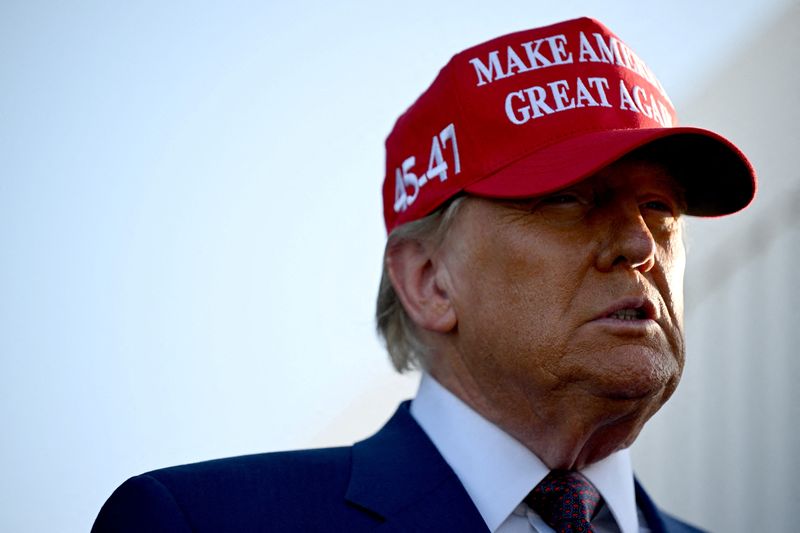By David Lawder
WASHINGTON (Reuters) - U.S. President-elect Donald Trump is widely expected to again turn to a favorite legal tool to underpin threatened tariffs on imports from Mexico, Canada and China: the International Emergency Economic Powers Act, one of several legal avenues to impose his broader tariff agenda.
Trump this week fired the first trade-related broadside of his second term - eight weeks before taking office - threatening 25% duties on goods from Mexico and Canada and an additional 10% tariffs on Chinese goods to push them to clamp down on the flow of the deadly opioid fentanyl and illegal migrants into the U.S.
Trade lawyers and other experts say there is ample authority for him to move quickly without approval from Congress. Here are the key tools he could use in his sweeping tariff agenda:
INTERNATIONAL EMERGENCY ECONOMIC POWERS ACT
Trump could declare a national emergency over the fentanyl crisis and the southern U.S. border, which would unlock the use of this statute, enacted in 1977 and updated in 2001 to impose tariffs or financial sanctions.
Trump invoked that statute a number of times during his first term, including to back up his threat of a 5% tariff on Mexican goods. He dropped the threat after Mexico vowed to deploy security forces to stem the flow of illegal immigrants into the U.S.
The then-Republican president also said the statute gave him the authority to "order" U.S. companies to leave China, and towards the end of his term in August 2020 he invoked the law again in an attempt to ban Chinese-owned video platform TikTok.
Congress can revoke the use of the statute by passing a joint declaration of disapproval. "But that's a heavy lift, especially for a Republican Congress" at the start of Trump's term, said Stephen Kho, a trade lawyer at Akin Gump and former China trade enforcement counsel at the Office of the U.S. Trade Representative.
Courts have generally upheld challenges to the statute and its predecessor, the 1917 Trading with the Enemy Act, which then-President Richard Nixon invoked in 1971 to impose a 10% supplemental duty on all U.S. imports to ease a balance of payments crisis and push Germany and Japan to revalue their currencies against the dollar.
SECTION 232, TRADE EXPANSION ACT OF 1962
Trump has proposed broad 10%-20% tariffs on all U.S. imports. Like Nixon, Trump could invoke the IEEPA for this, but would face a higher standard of defining an "unusual and extraordinary threat" to the national security, foreign policy or economy of the U.S.
Trade experts also say Trump could return to the Cold War-era Section 232 statute to underpin broader tariffs, but this would require a new investigation that could take months to complete.
Trump invoked Section 232 to impose tariffs of 25% on global steel imports and 10% on aluminum in 2018, but negotiated exemptions for Canada and Mexico a year later that eliminated their retaliatory tariffs on U.S. pork, beef, bourbon and other products.
SECTION 301, TRADE ACT OF 1974
Trump is likely to again turn to Section 301, the backbone of his 2018-2020 trade war against China, as he looks to super-size his tariffs on Chinese imports. The statute, which allows the U.S. to retaliate against trading partners' unfair practices, underpinned punitive duties of up to 25% on some $370 billion worth of Chinese imports, from semiconductors to machinery to toys after a USTR investigation found that China was misappropriating U.S. intellectual property and coercing the transfer of U.S. technology to Chinese firms.
Trump's newly nominated U.S. trade representative, Jamieson Greer, may be able to modify the existing China Section 301 findings to justify additional tariffs on Chinese goods, as current USTR Katherine Tai did to back President Joe Biden's sharply higher duties on electric vehicles, batteries, semiconductors and solar products.
But Greer may also launch a new Section 301 probe into China's state-driven excess industrial capacity - an increasing concern for the U.S. and market economies - and industry-domination practices. While trade lawyers say there is well-documented evidence of such practices, it would take likely several months for a new Section 301 probe to be completed, given the need for public comment periods and hearings.
SECTION 122, TRADE ACT OF 1974
Trump could invoke this balance-of-payments statute to impose an additional global U.S. tariff for 150 days to restrict imports in the event of balance-of-payments problems, or to prevent a significant depreciation of the dollar. Congress added this authority as a result of Nixon's 10% tariff action in 1971.
But the statute limits the tariff action to 150 days, unless extended by Congress.
SECTION 338, TARIFF ACT OF 1930

This anti-discrimination statute remains on the books, though it has not appeared in public government correspondence since the late 1940s. At that time, the U.S. and its trading partners agreed to "bound" global tariff rates under the post-war Global Agreement on Tariffs and Trade, the predecessor to today's World Trade Organization.
It would allow Trump to impose additional tariffs of up to 50% on goods from any country that discriminates against U.S. products in a way that puts American goods at a "disadvantage" compared to imports from other countries.